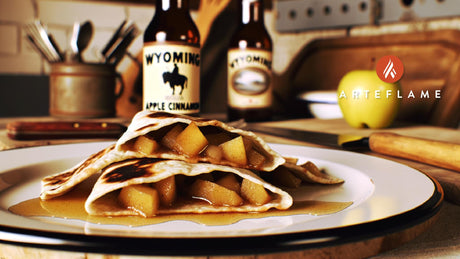Introducción
Pocas cosas se comparan con la simplicidad y la perfección de un filete premium de Virginia Black Angus, especialmente cuando se sella a más de 530 °C en la rejilla central de una parrilla Arteflame. Esta parrilla única le brinda una corteza con calidad de asador, conservando todos los jugos naturales. La plancha plana que rodea el centro también le permite controlar a la perfección la temperatura de cocción para obtener el máximo sabor y una textura tierna con el método de sellado inverso. Sin tapa, sin ollas ni sartenes, solo fuego, acero y sabor.
Ingredientes
- 2 filetes de costilla de Virginia Black Angus, de 1,5 a 2 pulgadas de grosor
- Sal kosher, al gusto
- Pimienta negra recién molida, al gusto
- 2 cucharadas de mantequilla sin sal
- Aceite vegetal (para encender la parrilla)
- 3 servilletas de papel
- Leña de madera dura (preferiblemente de roble o nogal)
Instrucciones
Paso 1: Encienda la parrilla Arteflame
- Remoje tres servilletas de papel en aceite vegetal y colóquelas en el centro del recipiente del fuego.
- Apila varios trozos de leña dura sobre las servilletas.
- Enciende las servilletas y deja que el fuego se avive. Deja que la parrilla se caliente durante 20 minutos hasta que la rejilla central alcance más de 535 °C.
Paso 2: Sazonar los filetes
- Seque los filetes de Virginia Black Angus con una toalla de papel.
- Sazone generosamente ambos lados con sal kosher y pimienta negra recién molida.
- Deje que los filetes alcancen la temperatura ambiente mientras se calienta la parrilla.
Paso 3: Sellar en la rejilla central
- Una vez que la rejilla central de la parrilla esté bien caliente (más de 1000 °F), coloque los filetes directamente sobre el fuego en la rejilla.
- Selle cada lado de 1,5 a 2 minutos para obtener una costra dorada. Use pinzas para sujetar los filetes y sellar también los bordes.
Paso 4: Terminar en la plancha plana
- Coloque los filetes en la zona plana de la plancha de cocción, alrededor de la rejilla central. Esta zona es más fría e ideal para sellar al revés.
- Añade una cucharada de mantequilla debajo de cada filete para rociarlos con un rico sabor a mantequilla mientras se cocinan.
- Controle la temperatura interna con un termómetro de sonda hasta que alcance 15 °F por debajo del punto de cocción deseado (e.g., 115°F para término medio).
Paso 5: Deje reposar los filetes
- Retire los filetes y déjelos reposar fuera del fuego durante 5 a 10 minutos.
- La temperatura interna continuará aumentando durante este tiempo, reteniendo los jugos.
- Córtelo en rodajas o sírvalo entero con sus acompañamientos favoritos.
Consejos
- Utilice las zonas interiores más calientes para sellar y las exteriores más frías para una cocción suave.
- No te saltes la etapa de reposo: ¡hace una gran diferencia!
- Utilice una sonda digital para obtener el punto de cocción más preciso.
- La mantequilla rocía el filete y realza su sabor maravillosamente.
- No condimente demasiado: con carne de calidad, sal y pimienta son todo lo que necesita.
Variaciones
- Filete de ajo y hierbas: Añade ajo picado y romero a la mantequilla durante la cocción final en la plancha para darle un toque aromático.
- Aliño de pimentón ahumado: Agregue pimentón ahumado y ajo en polvo a su mezcla de sal y pimienta para lograr una corteza más intensa.
- Corteza de espresso: Mezcle granos de espresso finamente molidos con pimienta para obtener un sabor profundo y rico.
- Bistec con chile frotado: Agregue pimienta cayena y hojuelas de chipotle para darle al filete un toque ahumado y picante.
- Costra de pimienta negra: Utilice pimienta negra gruesa para lograr un contraste de textura y un sabor intenso.
Las mejores combinaciones
- Puré de papas asadas con ajo cocinado en la plancha plana
- Espárragos carbonizados o brócoli a la parrilla rociados con mantequilla
- Mazorca de maíz fresca untada con mantequilla de hierbas
- Champiñones glaseados con balsámico cocinados junto con el filete.
- Una copa de vino tinto de Virginia o un cóctel de bourbon ahumado
Conclusión
Asar un filete Virginia Black Angus en el Arteflame se trata de un sabor intenso y una técnica perfecta. Con un sellado que solo el fuego y el acero pueden ofrecer, y la técnica inversa que remata cada filete a la perfección, este es el método ideal para obtener resultados de calidad profesional en tu propio patio trasero.
